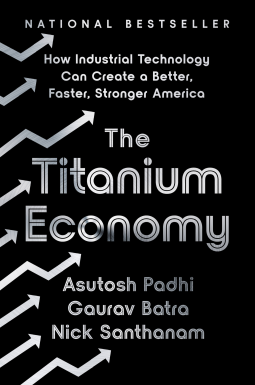
The Titanium Economy
How Industrial Technology Can Create a Better, Faster, Stronger America
by Asutosh Padhi; Gaurav Batra; Nick Santhanam
This title was previously available on NetGalley and is now archived.
Send NetGalley books directly to your Kindle or Kindle app
1
To read on a Kindle or Kindle app, please add kindle@netgalley.com as an approved email address to receive files in your Amazon account. Click here for step-by-step instructions.
2
Also find your Kindle email address within your Amazon account, and enter it here.
Pub Date Oct 25 2022 | Archive Date Oct 24 2022
Description
The future of the American economy is hiding in an unlikely place: the manufacturing sector
While Silicon Valley titans dominate headlines, many of the fastest-growing, most profitable companies in the United States are firms you’ve likely never heard of, such as HEICO, Trex, and Casella. These booming companies belong to a burgeoning sector—industrial tech—that offers surprising hope to workers, consumers, and investors alike.
Their role: to make a range of products—aerospace parts, for example, or recycled plastic lumber—that quietly form the backbone of America’s biggest industries.
In an age of instability, industrial tech is a cornerstone of our economic future. In this book, McKinsey veterans Asutosh Padhi, Gaurav Batra, and Nick Santhanam reveal the “titanium economy,” a modern, reinvented industrial sector complete with high-paying, domestic jobs;, soaring stock prices;, and critical infrastructure. They dispel the myth that the best of American manufacturing is behind us and illuminate an opportunity for a brighter future—if we can seize it.
Available Editions
| EDITION | Other Format |
| ISBN | 9781541701878 |
| PRICE | $29.00 (USD) |
| PAGES | 256 |
Featured Reviews
 Reviewer 902515
Reviewer 902515
Disclaimer: I'm not an expert in industrials or manufacturing.
The Titanium Economy is a remarkable book that delivers on everything it sets out to achieve. It's the one creative idea that has been scratching my noggin for a very long time.
Why it matters: The Titanium Economy sets up a brilliant vision of the companies that are building the future that exists outside of the traditional tech companies that dominate our economy; these old companies are as innovative as FAANG but pack an industrial punch that has a chance to build America's middle class and will become especially important as we enter these hard economic times.
One improvement: I wish the authors of the book could have included a direct section that outlines all of the companies you can invest in in the introduction; I had to dig to the back of the charts area to find the information since I wanted to do further research.
The bottom line: The Titanium Economy blends storytelling, market research, history, and economics in a symphony that presents a bold, bright, and contrarian vision of what the future of American economy can look like; small companies tackling niches to build a better future.



